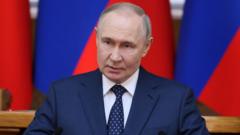Today marks a pivotal moment in Canadian politics as citizens cast their votes in a parliamentary election shaped by external pressures, including US tariffs and political upheaval. The Liberal Party, under newcomer Mark Carney, faces off against the Conservative Party led by Pierre Poilievre.**
Canada at a Crossroads: Election Day Sees Shifting Political Landscape Amidst Trumpian Tensions**

Canada at a Crossroads: Election Day Sees Shifting Political Landscape Amidst Trumpian Tensions**
As Canadians head to the polls, the political dynamics have shifted dramatically under the weight of President Trump's policies and the resignation of former Prime Minister Justin Trudeau.**
Canadians are heading to the ballot boxes today in what has become an election marked by tumult and uncertainty. The outcome promises to redefine the nation’s response to President Trump’s aggressive stance on trade, alongside the political fallout from former Prime Minister Justin Trudeau’s resignation. For many, today’s vote is not simply about choosing a leader; it’s about setting a course for the country’s economic future.
Recent polls indicate a surprising lead for the Liberal Party, now fronted by Mark Carney, over the Conservative Party led by Pierre Poilievre. Just months ago, the Conservatives enjoyed a comfortable 25-point lead, suggesting a straightforward path to victory. However, the tide turned dramatically following Trudeau’s exit from politics and an escalating trade war with the U.S., which has sent shockwaves through Canada’s economic landscape.
Mark Carney, formerly the governor of the Bank of Canada, is presenting himself as the candidate best equipped to confront the challenges posed by the Trump administration, particularly its tariffs and claims of annexing Canadian territory. His background in finance has become a cornerstone of his campaign, as he vows to strengthen Canada’s economic independence.
Conversely, Poilievre, a career politician, has been positioned as a proponent of deregulation and a smaller government, mirroring the populist, anti-elite sentiments found among Trump’s supporters. Yet, his alignment with Trump may alienate moderate voters who are wary of American influence in Canadian affairs.
Beyond the major parties, three additional contenders are vying for parliamentary seats, including the New Democratic Party (NDP) and the Bloc Quebecois. However, they appear less likely to sway the overall outcome, given the current focus on the contrasting visions of Carney and Poilievre.
Voter concerns today extend beyond traditional issues. The devastating impact of rising living costs, particularly housing affordability, remains at the forefront of public sentiment. Many Canadians are feeling the financial pinch, with urban centers becoming increasingly inhospitable for working families.
As polls open across the country with staggered closing times to accommodate its vast geography, voter turnout is expected to be significant. Results will trickle in late tonight, and while Canadians are skeptical about who can genuinely address their needs, the uncertainty surrounding U.S.-Canada relations looms large over the electoral process. The outcome of this election could have lasting implications for a nation navigating its identity at a precarious moment on the world stage.






















